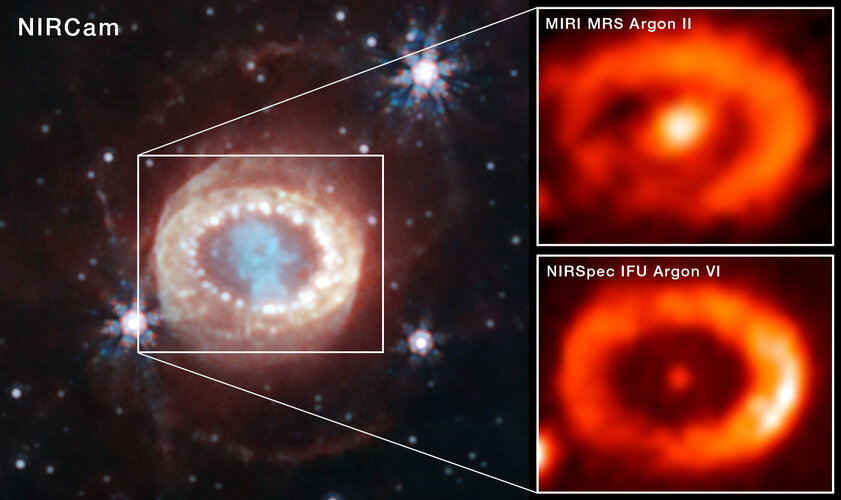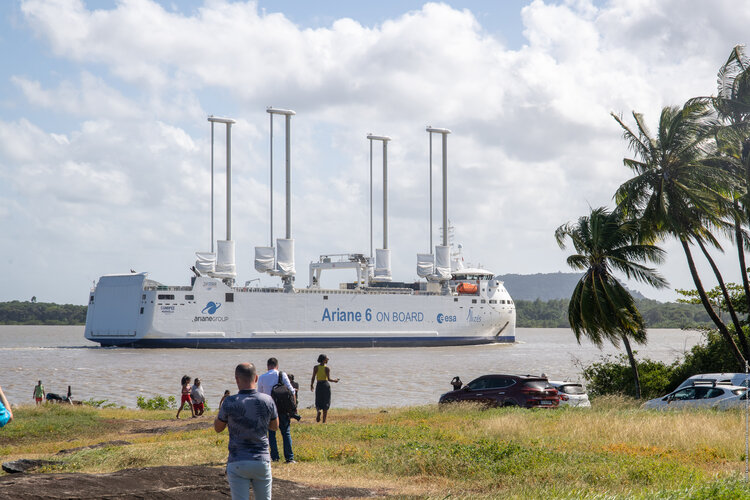
Copernical Team
Webb finds clues of neutron star at heart of supernova remnant

The NASA/ESA/CSA James Webb Space Telescope has found the best evidence yet for emission from a neutron star at the site of a recently observed supernova. The supernova, known as SN 1987A, occurred 160 000 light-years from Earth in the Large Magellanic Cloud. SN 1987A was observed on Earth in 1987, the first supernova that was visible to the naked eye since 1604 — before the advent of telescopes.
What to know about the NASA-funded commercial Moon fleet
 The year 2024 promises to be a busy one for American Moon landings, all under a new partnership between NASA and the space industry.
A first attempt under the Commercial Lunar Payload Services (CLPS) initiative ended in disappointing failure last month, but a second, led by Houston-based Intuitive Machines, will attempt on Thursday to return the United States to Moon for the first time in fi
The year 2024 promises to be a busy one for American Moon landings, all under a new partnership between NASA and the space industry.
A first attempt under the Commercial Lunar Payload Services (CLPS) initiative ended in disappointing failure last month, but a second, led by Houston-based Intuitive Machines, will attempt on Thursday to return the United States to Moon for the first time in fi Commercial spaceship set for lunar touchdown, in test for US industry
 A company from Texas is poised to attempt a feat that until now has only been accomplished by a handful of national space agencies, but could soon become commonplace for the private sector: landing on the Moon.
If all goes to plan, Houston-based Intuitive Machines will guide its spaceship named Odysseus to a gentle touchdown near the lunar south pole on Thursday at 2249 GMT, then run experim
A company from Texas is poised to attempt a feat that until now has only been accomplished by a handful of national space agencies, but could soon become commonplace for the private sector: landing on the Moon.
If all goes to plan, Houston-based Intuitive Machines will guide its spaceship named Odysseus to a gentle touchdown near the lunar south pole on Thursday at 2249 GMT, then run experim NanoMagSat and Tango Scout missions get go-ahead

Further embracing the New Space era, ESA is to develop two new Scout satellites: NanoMagSat and Tango. NanoMagSat will measure Earth’s magnetic field to help assess space weather hazards and continue on from ESA’s current Swarm mission. Tango will measure greenhouse-gas emissions from human activity and complements the upcoming Copernicus Carbon Dioxide Monitoring mission and the Sentinel-5 mission, as well as the current Sentinel-5P mission.
Ariane 6 arrives at Europe’s Spaceport via Canopée
 Image:
Ariane 6 arrives at Europe’s Spaceport via Canopée
Image:
Ariane 6 arrives at Europe’s Spaceport via Canopée ERS-2 reenters Earth’s atmosphere over Pacific Ocean

NASA joins National Wildfire Coordinating Group
 In a significant move to bolster the United States' wildfire management efforts, NASA has officially become an associate member of the National Wildfire Coordinating Group (NWCG). This collaboration opens new avenues for the space agency to work alongside federal agencies and other partners, leveraging its vast technological and innovative resources to enhance understanding and management of wil
In a significant move to bolster the United States' wildfire management efforts, NASA has officially become an associate member of the National Wildfire Coordinating Group (NWCG). This collaboration opens new avenues for the space agency to work alongside federal agencies and other partners, leveraging its vast technological and innovative resources to enhance understanding and management of wil New Deep Learning Approach to Boost Aerosol Measurement Accuracy in Space
 In a significant advancement for atmospheric science, researchers have introduced a novel algorithm designed to enhance the accuracy of aerosol monitoring using China's FY-4A satellite. This development, detailed in a recent publication in the journal Engineering, represents a collaborative effort among the Institute of Atmospheric Physics (IAP) of the Chinese Academy of Sciences, the National S
In a significant advancement for atmospheric science, researchers have introduced a novel algorithm designed to enhance the accuracy of aerosol monitoring using China's FY-4A satellite. This development, detailed in a recent publication in the journal Engineering, represents a collaborative effort among the Institute of Atmospheric Physics (IAP) of the Chinese Academy of Sciences, the National S Beyond what's possible: New JWST observations unearth mysterious ancient galaxies
 Our understanding of how galaxies form and the nature of dark matter could be completely upended, after new observations of a stellar population bigger than the Milky Way from more than 11 billion years ago that should not exist.
A paper published today in Nature details findings using new data from the James Webb Space Telescope (JWST). The results finds that a massive galaxy in the early
Our understanding of how galaxies form and the nature of dark matter could be completely upended, after new observations of a stellar population bigger than the Milky Way from more than 11 billion years ago that should not exist.
A paper published today in Nature details findings using new data from the James Webb Space Telescope (JWST). The results finds that a massive galaxy in the early Equatorial Launch Australia Partners with Equatorial Space Systems for Rocket Launches in 2024
 In a significant development for the global aerospace industry, Equatorial Launch Australia (ELA), a leading spaceport operator and infrastructure provider, has announced a strategic partnership with Singapore-based Equatorial Space Systems (ESS). This collaboration is set to bring a series of suborbital launches to the Arnhem Space Centre in late 2024, marking a pivotal moment for both entities
In a significant development for the global aerospace industry, Equatorial Launch Australia (ELA), a leading spaceport operator and infrastructure provider, has announced a strategic partnership with Singapore-based Equatorial Space Systems (ESS). This collaboration is set to bring a series of suborbital launches to the Arnhem Space Centre in late 2024, marking a pivotal moment for both entities 
